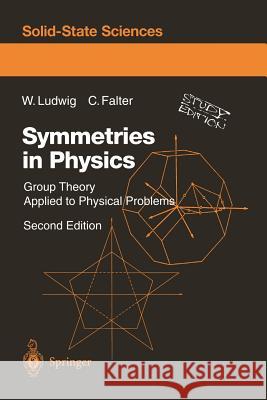Symmetries in Physics: Group Theory Applied to Physical Problems » książka



Symmetries in Physics: Group Theory Applied to Physical Problems
ISBN-13: 9783540602842 / Angielski / Miękka / 1996 / 473 str.
Symmetries in Physics presents the fundamental theories of symmetry, together with many examples of applications taken from several different branches of physics. Emphasis is placed on the theory of group representations and on the powerful method of projection operators. The excercises are intended to stimulate readers to apply the techniques demonstrated in the text.
1. Introduction.- 2. Elements of the Theory of Finite Groups.- 2.1 Symmetry and Group Concepts: A Basic Example.- 2.2 General Theorems on Group Theory.- 2.3 Conjugacy Classes.- 3. Discrete Symmetry Groups.- 3.1 Point Groups.- 3.1.1 Symmetry Elements.- 3.1.2 Proper Point Groups.- 3.1.3 Improper Point Groups.- 3.2 Colour Groups and Magnetic Groups.- 3.3 Double Groups.- 3.4 Lattices, the Translation Group and Space Group.- 3.4.1 Normal Space Groups.- 3.4.2 Colour and Magnetic Space Groups.- 3.4.3 Double Space Groups.- 3.5 Permutation Groups.- 3.6 Other Finite Groups.- 4. Representations of Finite Groups.- 4.1 Linear Spaces and Operators.- 4.1.1 Linear and Unitary Spaces.- 4.1.2 Linear Operators.- 4.1.3 Special Operators and Eigenvalues.- 4.2 Introduction to the Theory of Representations.- 4.2.1 Operator Representations by Matrices.- 4.2.2 Equivalent Representations and Characters.- 4.2.3 Reducible and Irreducible Representations.- 4.2.4 Orthogonality Theorems.- 4.2.5 Subduction. Reality of Representations.- 4.3 Group Algebra.- 4.3.1 The Regular Representation.- 4.3.2 Projection Operators.- 4.4 Direct Products.- 4.4.1 Representations of Direct Products of Groups.- 4.4.2 The Inner Direct Product of Representations of a Group. Clebsch-Gordan Expansion.- 4.4.3 Simply Reducible Groups.- 5. Irreducible Representations of Special Groups.- 5.1 Point and Double Point Groups.- 5.2 Magnetic Point Groups. Time Reversal.- 5.3 Translation Groups.- 5.4 Permutation Groups.- 5.5 Tensor Representations.- 5.5.1 Tensor Transformations. Irreducible Tensors.- 5.5.2 Induced Representations.- 5.5.3 Irreducible Tensor Spaces.- 5.5.4 Direct Products and Their Reduction.- 6. Tensor Operators and Expectation Values.- 6.1 Tensors and Spinors.- 6.2 The Wigner-Eckart Theorem.- 6.3 Eigenvalue Problems.- 6.4 Perturbation Calculus.- 7. Molecular Spectra.- 7.1 Molecular Vibrations.- 7.1.1 Equation of Motion and Symmetry.- 7.1.2 Determination of Eigenvalues and Eigenvectors.- 7.1.3 Selection Rules.- 7.2 Electron Functions and Spectra.- 7.2.1 Symmetry in Many-Particle Systems.- 7.2.2 Symmetry-Adapted Atomic and Molecular Orbitals.- 7.2.3 The Hückel Method and Ligand Field Theory.- 7.3 Many-Electron Problems.- 7.3.1 Permutation Symmetry.- 7.3.2 Point and Permutation Symmetry. Molecular States.- 7.3.3 The H2 Molecule.- 8. Selection Rules and Matrix Elements.- 8.1 Selection Rules of Tensor Operators.- 8.2 The Jahn-Teller Theorem.- 8.2.1 Spinless States.- 8.2.2 Time Reversal Symmetry.- 8.3 Radiative Transitions.- 8.4 Crystal Field Theory.- 8.4.1 Crystal Field Splitting of Energy Levels.- 8.4.2 Calculation of Splitting.- 8.5 Independent Components of Material Tensors.- 9. Representations of Space Groups.- 9.1 Representations of Normal Space Groups.- 9.1.1 Decompositions into Cosets.- 9.1.2 Induction of the Representations of R.- 9.2 Allowable Irreducible Representations of the Little Group Gk.- 9.2.1 Projective Representations. Representations with a Factor System for $${\mathcal_{}} = {\mathcal_k}/\mathbb$$.- 9.2.2 Vector Representations of the Groupe $${\mathcal_k} = {\mathcal_k}/{\mathbb_k}$$.- 9.2.3 Representations of Double Space Groups. Spinor Representations.- 9.3 Projection Operators and Basis Functions.- 9.4 Representations of Magnetic Space Groups.- 9.4.1 Corepresentations of Magnetic Space Groups.- 9.4.2 Time Reversal Symmetry in MII Groups.- 10. Excitation Spectra and Selection Rules in Crystals.- 10.1 Spectra — Some General Statements.- 10.1.1 Bands and Branches.- 10.1.2 Compatibility Relations.- 10.2 Lattice Vibrations.- 10.2.1 Equation of Motion and Symmetry Properties.- 10.2.2 Vibrations of the Diamond Lattice.- 10.3 Electron Energy Bands.- 10.3.1 Symmetrization of Plane Waves.- 10.3.2 Energy Bands and Atomic Levels.- 10.4 Selection Rules for Interactions in Crystals.- 10.4.1 Determination of Reduction Coefficients.- 10.4.2 General Selection Rules.- 10.4.3 Electron-Phonon Interaction.- 10.4.4 Electron-Photon Interaction: Optical Transitions.- 10.4.5 Phonon-Photon Interaction.- 11. Lie Groups and Lie Algebras.- 11.1 General Foundations.- 11.1.1 Infinitesimal Generators and Defining Relations.- 11.1.2 Algebra and Parameter Space.- 11.1.3 Casimir Operators.- 11.2 Unitary Representations of Lie Groups.- 11.3 Clebsch-Gordan Coefficients and the Wigner-Eckart.- Theorem.- 11.4 The Cartan-Weyl Basis for Semisimple Lie Algebras.- 11.4.1 The Lie Group LU (n, ?) and the Lie Algebra An-1..- 11.4.2 The Cartan-Weyl Basis.- 12. Representations by Young Diagrams. The Method of Irreducible Tensors.- 13. Applications of the Theory of Continuous Groups.- 13.1 Elementary Particle Spectra.- 13.1.1 General Remarks.- 13.1.2 Hadronic States.- 13.1.3 Colour States of Quarks.- 13.1.4 A Possible LU (4) Classification.- 13.2 Atomic Spectra.- 13.2.1 Russell-Saunders (LS) Coupling.- 13.2.2 jj Coupling.- 13.3 Nuclear Spectra.- 13.3.1 jj-JI Coupling.- 13.3.2 LSI Coupling.- 13.4 Dynamical Symmetries of Classical Systems.- 14. Internal Symmetries and Gauge Theories.- 14.1 Internal Symmetries of Fields.- 14.2 Gauge Transformations of the First Kind.- 14.2.1 U (1) Gauge Transformations.- 14.2.2 LU (n) Gauge Transformations.- 14.3 Gauge Transformations of the Second Kind.- 14.3.1 U (1) Gauge Transformations of the Second Kind.- 14.3.2 LU (n) Gauge Transformations of the Second Kind.- 14.3.3 A Differential Geometric Discussion of the Yang-Mills Fields.- 14.4 Gauge Theories with Spontaneously Broken Symmetry.- 14.4.1 General Remarks.- 14.4.2 Spontaneous Breaking of a Gauge Symmetry of the First Kind: Goldstone Model.- 14.4.3 Spontaneous Breaking of an Abelian Gauge Symmetry of the Second Kind: Higgs-Kibble Model.- 14.5 Non-Abelian Gauge Theories and Symmetry Breaking.- 14.5.1 The Glashow-Salam-Weinberg Model of the Electro-Weak Interaction.- 14.5.2 Symmetry Breaking in the Glashow-Salam-Weinberg Model.- 14.5.3 Grand Unified Theories: General Remarks.- 14.5.4 LU (5) Group and Georgi-Glashow Model.- 14.5.5 Some Consequences of LU (5) Theory.- Appendices.- A. Character Tables.- B. Representations of Generators.- C. Standard Young-Yamanouchi Representations of the Permutation Groups P3 - P5.- D. Continuous Groups.- E. Stars of k and Symmetry of Special k-Vectors.- F. Noether’s Theorem.- G. Space-Time Symmetry.- G.1 Canonical Transformations and Algebra.- G.2 The Galilei Group and Classical Mechanics.- G.3 Lorentz and Poincaré Groups.- G.4 The Physical Quantities.- H. Goldstone’s Theorem.- I. Remarks on 5-fold Symmetry.- J. Supersymmetry.- K. List of Symbols and Abbreviations.- References.- Additional Reading.
Symmetries in Physics presents the fundamental theories of symmetry, together with many examples of applications taken from several different branches of physics. Emphasis is placed on the theory of group representations and on the powerful method of projection operators. The excercises are intended to stimulate readers to apply the techniques demonstrated in the text.
1997-2025 DolnySlask.com Agencja Internetowa
KrainaKsiazek.PL - Księgarnia Internetowa









